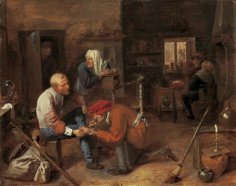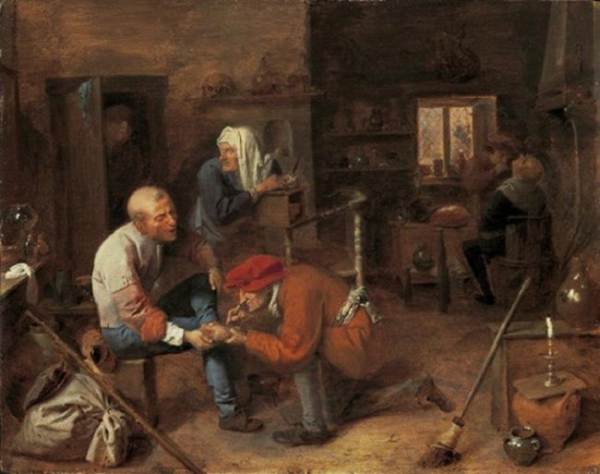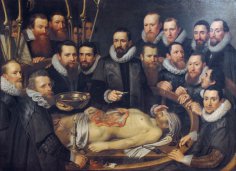
“This painting dates from just after Brouwer's arrival in Antwerp, where he came from Haarlem or Amsterdam. Barber, charlatan, and surgeon—the village barber can do anything. Here, he operates on a patient's leg. Typical of Brouwer, in addition to his emotionality, are the moments captured from life and the precisely colored fabrics that stand out against the somewhat dull palette.” (Accompanying text on the museum's website.)
A dark and dingy room in a squalid house: a dirt floor, a dim window, and sparse furniture. A fireplace with a conical chimney is visible in the far right corner, just off-center.
In the foreground on the right is a bench with a bottle on it; closer to the viewer is a jug covered with a board, on which rests a candlestick. A broom rests on the bench (its design is almost contemporary, while the painting is four hundred years old!).
In the center of the painting is a figure seated on a box, wearing light blue trousers and a jacket, from under which a white shirt with a large turn-down collar peeks out. He is hopelessly bald, with only a forelock remaining. Perhaps this is the result of some illness. The poor fellow may have been walking somewhere far away or from afar (in the left corner are a stick, a hat, and a large bag with a tied neck). Most likely, he has a splinter in his foot for some time now; the splinter has become inflamed, and the specialist sitting opposite him is cutting the abscess. It hurts, and the patient even lifts his left hand in pain, his mouth slightly open in a suppressed groan.
In the background is an elderly woman at a counter. She is wearing a dark blouse and a long, floor-length skirt. Immediately behind her is a half-open door to the hallway, and on the wall is a shelf with a skull (a symbol of a doctor). The woman holds a pen in her left hand, apparently keeping track of visitors. What else is she recording—income and expense transactions? Most likely, this is the doctor's wife, who also serves as the cleaning lady. She is somewhat displeased that another visitor (visible in the doorway) is intruding on such a tense moment.
The combination of the desk and the chair looks a bit strange: either the desk is hanging in the air, or the chair is broken.
A barber in a red hat, white shirt, and jacket belted with either a towel or a wide sash stands before his visitor, kneeling. He wears shoes with soles that are falling off (something is visible under his left foot; perhaps it's not a sole, but a stick of some kind). He's nearsighted, his nose is almost in the wound, but he holds himself confidently, holding both his foot and the knife firmly. He's apparently preparing to make an incision: the knife is near the abscess, but there's no blood yet. He's focused, like a lion about to spring.
The unsanitary conditions are appalling; there's not even a basin of water to wash your hands or wet a rag to wipe down the surgical site. But there's no other option; there's only one expert who can help.
And what's going on in the corner by the window? In the wall space is a shelf with bottles and vials. A patient sits on a chair, facing the light, his head thrown back. To his left is a nightstand with his hat and several objects of unknown purpose (presumably a razor whetstone, some kind of soap, and some kind of hemostatic agent). And in front of him is a barber, trimming his beard.
The barber shop is open…

Adriaen Brouwer, The Village Barber Shop, 31×40 cm, 1631, Alte Pinakothek Munich, Germany





